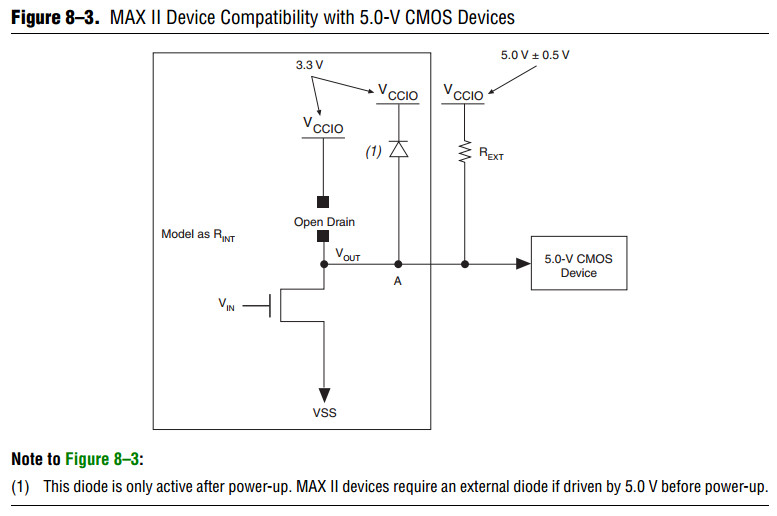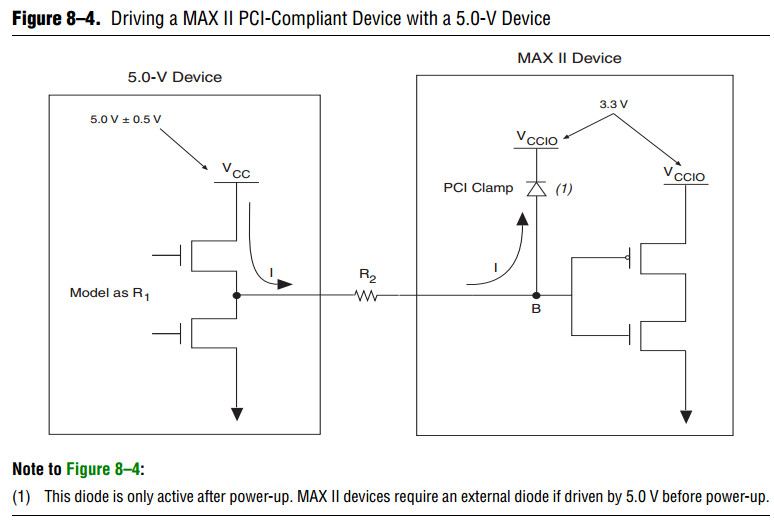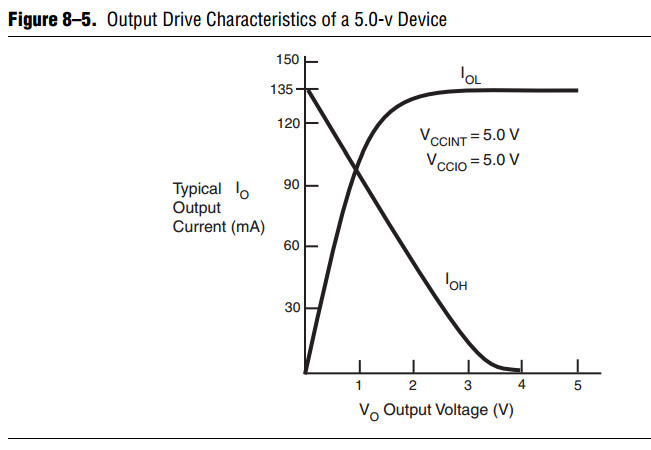MAX II Device Compatibility with 5.0-V CMOS Devices
http://www.altera.com/literature/hb/max2/max2_mii51009.pdf

The open-drain pin never drives high, only low or tri-state. When the open-drain pin is active, it drives low.
When the open-drain pin is inactive, the pin is tri-stated and the trace pulls up to 5.0 V by the external resistor.
The purpose of enabling the I/O clamp diode is to protect the MAX II device’s I/O pins.
The 3.3-V VCCIO supplied to the I/O clamp diodes causes the voltage at point A to clamp at 4.0 V,
which meets the MAX II device’s reliability limits when the trace voltage exceeds 4.0 V.
The device operates successfully because a 5.0-V input is within its input specification.
The I/O clamp diode is only supported in the EPM1270 and EPM2210 devices’ I/O Bank 3.
An external protection diode is needed for other I/O banks in EPM1270 and EPM2210 devices
and all I/O pins in EPM240 and EPM570 devices.
The pull-up resistor value should be small enough for sufficient signal rise time,
but large enough so that it does not violate the IOL (output low) specification of MAX II devices.
The maximum MAX II device IOL depends on the programmable drive strength of the I/O output.
Table 8–1 shows the programmable drive strength settings
that are available for the 3.3-V LVTTL/LVCMOS I/O standard for MAX II devices.
The Quartus II software uses the maximum current strength as the default setting.
The PCI I/O standard is always set at 20 mA with no alternate setting.

To compute the required value of REXT, first calculate the model of the open-drain
transistors on the MAX II device. This output resistor (REXT) can be modeled by
dividing VOL by IOL (REXT = VOL/IOL). Table 8–2 shows the maximum VOL for the 3.3-V
LVTTL/LVCMOS I/O standard for MAX II devices.
f For more information about I/O standard specifications, refer to the DC and Switching
Characteristics chapter in the MAX II Device Handbook.

Select REXT so that the MAX II device’s IOL specification is not violated. You can
compute the required pull-up resistor value of REXT by using the equation: REXT =
(VCC/IOL) – RINT. For example, if an I/O pin is configured as a 3.3-V LVTTL with a 16
mA drive strength, given that the maximum power supply (VCC) is 5.5 V, the value of
REXT can be calculated as follows:

This resistor value computation assumes worst-case conditions. You can adjust the
REXT value according to the device configuration drive strength. Additionally, if your
system does not see a wide variation in voltage-supply levels, you can adjust these
calculations accordingly.

Because MAX II devices are 3.3-V, 32-bit, 66-MHz PCI compliant, the input circuitry
accepts a maximum high-level input voltage (VIH) of 4.0 V.
To drive a MAX II device with a 5.0-V device, you must connect a resistor (R2)
between the MAX II device and the 5.0-V device. See Figure 8–4.
If VCCIO for MAX II devices is 3.3 V and the I/O clamp diode is enabled, the voltage at point B in Figure 8–4 is 4.0 V,
which meets the MAX II devices reliability limits when the trace voltage exceeds 4.0 V.
To limit large current draw from the 5.0-V device, R2 should be small enough for a fast signal rise time
and large enough so that it does not violate the high-level output current (IOH) specifications of the devices driving the trace.
To compute the required value of R2, first calculate the model of the pull-up transistors on the 5.0-V device.
This output resistor (R1) can be modeled by dividing the 5.0-V device supply voltage (VCC) by the IOH: R1 = VCC/IOH
Figure 8–5 shows an example of typical output drive characteristics of a 5.0-V device.

As shown above, R1 = 5.0 V/135 mA.
The values usually shown in data sheets reflect typical operating conditions.
Subtract 20% from the data sheet value for guard band.
This subtraction applied to the above example gives R1 a value of 30.
Select R2 so that the MAX II device’s IOH specification is not violated. For example,
if the above device has a maximum IOH of 8 mA, given the I/O clamp diode,
VIN = VCCIO + 0.7 V = 3.7 V.
Given that the maximum supply load of a 5.0-V device (VCC) is 5.5 V, the value of R2
can be calculated as follows:

This analysis assumes worst-case conditions. If your system does not see a wide
variation in voltage-supply levels, you can adjust these calculations accordingly.
Because 5.0-V device tolerance in MAX II devices requires use of the I/O clamp, and
this clamp is activated only after power-up, 5.0-V signals may not be driven into the
device until it is configured.
The I/O clamp diode is only supported in the EPM1270 and EPM2210 devices’ I/O Bank 3.
An external protection diode is needed for other I/O banks for EPM1270 and EPM2210 devices
and all I/O pins in EPM240 and EPM570 devices.
MAX II Device Compatibility with 5.0-V CMOS Devices的更多相关文章
- Multiplexing SDIO Devices Using MAX II or CoolRunner-II CPLD
XAPP906 Supporting Multiple SD Devices with CoolRunner-II CPLDs There has been an increasing demand ...
- Delphi XE5 Device compatibility
Delphi XE5 Device compatibility https://docs.google.com/spreadsheet/ccc?key=0AoEN2CEsVvJ0dGhVaWJE ...
- 3、一、Introduction(入门):2、Device Compatibility(设备兼容性)
2.Device Compatibility(设备兼容性) Android is designed to run on many different types of devices, from ...
- java.lang.UnsatisfiedLinkError: org.apache.hadoop.util.NativeCrc32.nativeComputeChunkedSumsByteArray(II[BI[BIILjava/lang/String;JZ)V
环境: Spark2.1.0 .Hadoop-2.7.5 代码运行系统:Win 7在运行Spark程序写出文件(savaAsTextFile)的时候,我遇到了这个错误: // :: ERROR U ...
- Android Google官方文档解析之——Device Compatibility
Android is designed to run on many different types of devices, from phones to tablets and television ...
- win7上代码连接hadoop出现错误 :org.apache.hadoop.util.NativeCrc32.nativeComputeChunkedSumsByteArray(II[BI[BIILjava/lang/String;JZ)V
在idea和eclipse中调试hadoop中hdfs文件,之前好好的,结果突然就出现java.lang.UnsatisfiedLinkError: org.apache.hadoop.util.Na ...
- 关于freemarker标签+Spring3.0 V层学习
import标签 就是把其他的ftl页面引用进来 <#import "/common/ui.ftl" as ui> 使用时 <@ui.message/>,m ...
- linux内核挂载根文件系统时报错”VFS: Cannot open root device "ram0" or unknown-block(0,0): error -6“如何处理?
1. 通过error -6得到: #define ENXIO 6 /* No such device or address */ 2. 解决办法 使能CONFIG_BL ...
- VFS: Cannot open root device "nfs" or unknown-block(0,255)错误的解决
1. 解决办法:在内核配置时候文件系统中选中Root file system on NFS
随机推荐
- html-示例代码
<!DOCTYPE html> <html lang="en" xmlns="http://www.w3.org/1999/html" xml ...
- java多线程-读写锁原理
Java5 在 java.util.concurrent 包中已经包含了读写锁.尽管如此,我们还是应该了解其实现背后的原理. 读/写锁的 Java 实现(Read / Write Lock Java ...
- (二)Mybatis项目配置
第一节:environments Mybatis支持多个环境,可以任意配置 <environments default="development"> <envir ...
- Java事务管理之JDBC
前言 关于Java中JDBC的一些使用可以参见: Java 中使用JDBC连接数据库例程与注意事项 在使用JDBC的使用, 如何进行事务的管理.直接看一下代码 示例代码 /** * @Title: J ...
- MySQL学习笔记:exists和in的区别
一.exists函数 表示存在,常常与子查询配合使用. 用于检查子查询是否至少会返回一行数据,该子查询实际上并不返回任何数据,而是返回值True或False. 当子查询返回为真时,则外层查询语句将进行 ...
- java解析Xml格式的字符串
最近在工作中,需要调别的接口,接口返回的是一个字符串,而且内容是xml格式的,结果在解析json的时候报错,最终修改了接口的返回方式,以Map返回, 才得以接收到这个xml的字符串,然后通过dom4j ...
- 一步一步学习IdentityServer3 (15) 授权模式那些事
总结一句话,其实很简单 在什么Clients 拿的认证权限Scope 就去 去开什么Scope限制的服务接口门 在写Clients的时候,会有Scope,看下面的代码 new Client { Cli ...
- 004 Hadoop2.x基础知识
一:大数据应用 1.Cloudera cloudera公司是Hadoop三大发行商之一,其版本为CDH版本,现在最新的版本是CDH5. 网站:http://archive.cloudera.com/c ...
- CentOS 7下MySQL5.7.23的服务配置参数测试
CentOS 7默认安装MySQL5.7.23,服务管理发生了变化,从sysvinit(service mysql start)变化为systemd(systemctl start mysqld.se ...
- C++ 几种经典的垃圾回收算法
之前遇到了一篇好文(https://blog.csdn.net/wallwind/article/details/6889917)准备学习一下的,课程繁忙就忘记了,今日得闲,特来补一下. 自己写一遍加 ...
